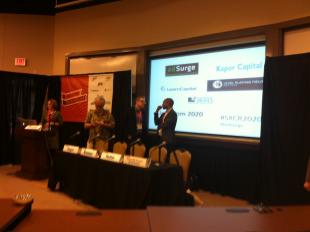Venture Capital in Education: New Technology and New Solutions


At last week’s SXSW interactive conference, blogger Betsy Corcoran of EdSurge convened a panel discussion among venture capitalists on the future of education technology: “Classroom 2020: VCs and the Education Revolution”. Participants included Mitch Kapor of Kapor Capital, Phillip Bronner of Novak Biddle Venture Partners and Rob Hutter of LearnCapital.
Education startups are “hot” right now, with stories on TechCrunch, big funding rounds and pop culture attention. But what really matters is not tech hype, but the need: Better solutions for schools, universities and workplace training. At the SXSW panel, the participants set the stage by enumerating the social factors that drive their focus on education: American students’ abysmal performance in science, math and engineering, rising wage inequality and decreasing numbers of jobs available to less-skilled adults.
These investors have a broader vision of investing. They look for more than just successful technology, but technology that creates social value. Kapor, Bronner and Hutter view themselves as impact investors, seeking companies that work in the rich target area of needed innovation in education, from delivering content to tailoring lesson plans to individual students.
The Social Media Inflection Point
For the last 20 - 30 years, schools have experimented with technology tools to deliver rich educational experiences. So why is the education area so interesting right now? New web technologies, like social media, are bringing educational technology to an inflection point, where technology can create rich experiences that deliver education online, with dramatically reduced cost.
Hutter shared several compelling examples of tech solutions for educational challenges. In Mooresville, North Carolina, a 1:1 laptop program resulted in substantial improvement in achievement and graduation rates. At KIPP Empower Academy in California, controlled experiments revealed that 98% of students who began the school year below average performance standards either met or exceeded standards after participating in a blended learning program.
There’s compelling evidence (beyond just these stories) that online learning is useful. The question is not whether technology is effective - it’s determining the appropriate dosage, and developing scale. How do we bring blended learning from case studies with 20 kids to 20 million kids?
Those sweet spots are where Hutter, Kapor and Bronner are eager to invest: Technology that delivers, manages and personalizes blended learning solutions for thousands and millions of students.
Content Is Not Tied to the Classroom
There are three components of the education system:
- Content: The educational information to be read, learned and understood.
- Mastery: Developing the ability to not just regurgitate the information, but provide analysis, critical thinking and demonstration of skills.
- Certification: Demonstrating mastery of the content to the outside world (through diplomas, certifications and other evidence).
Kapor outlined the balance that he believes the education system needs to achieve: "Let's all watch Khan Academy explain algebra and let teachers act as personal coaches. Kids need to be making things and doing projects, and that’s where teachers can make a real difference.”
All three panelists advocated untethering the delivery and consumption of content from the classroom boundaries. Content can created, delivered and consumed anywhere - and anytime. But content isn’t everything. Mastery is achieved through practice, reflection, interaction and exploration of new information and new skills, all experiences that can be facilitated in classrooms, with peers and online.
OpenSesame’s Place in the Future of Education
As a spectator in this discussion (albeit one furiously taking notes), I had one recurring thought - where does training fit into this? Primary education comes first, both literally and figuratively, but vocational training, professional development and technical skills are all essential for reinvigorating our stalled economy and adapting the American workforce to a skilled future.
OpenSesame has entered the education technology market with a focus on the professional training sector because corporations are more comfortable with elearning and technology than schools our - but in the long term we hope our marketplace will be the central catalog for any learning content.
We view ourselves is the content resource for the blended classroom. With a simple, easy to use platform for buying, selling and finding learning content, OpenSesame ensures that individuals and institutions can find learning content to support the in-depth, in-person learning experience.



